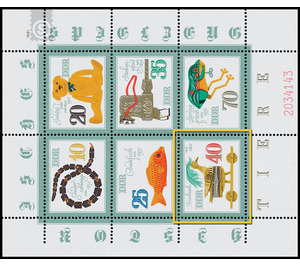Commemorative stamp series - Germany / German Democratic Republic 1981 - 40 Pfennig
Theme: Post & Philately
| Country | Germany / German Democratic Republic |
| Issue Date | 1981 |
| Face Value | 40.00 |
| Color | yellow green |
| Perforation | K 13 1/2: 13 |
| Printing Type | offset |
| Stamp Type | Postage stamp |
| Item Type | Stamp |
| Chronological Issue Number | 2407 |
| Chronological Chapter | GER-DDR |
| SID | 414373 |
| In 13 Wishlists | |
Historical Toys - Animals With illustrations of historical toy animals, the Ministry of Posts and Telecommunications of the German Democratic Republic publishes six multicolored special postage stamps printed together on a miniature sheet. No special first day cover envelope Special cancellation from 24th November 1981 to 23rd January 1982 Historic toys - animals Play animals occupy an important place in the motif treasure of the toy today as ever, because their role models are an important part of our environment. They awaken and promote in the child the knowledge of the meaning of the animal for humans, whether as part of the surrounding nature, as a useful pet or as a comrade and playmate. The game animals selected for the special postage stamp issue may stand for this finding. Over a period of two hundred years, to which these testimonies belong, different materials and technical means have been used to design the characteristics of different animals and to develop manageable toys. The cuckoo on bellows voice and wheels to (40-pfennig value) was manufactured around 1800 in the Sonneberg area. The connection of a mechanical effect - here the gear train - with an acoustic was already very popular at that time. The cuckoo voice, which we also know from children's instruments from other contemporary toy production areas, was used most frequently. In this context, attention should be drawn to Leopold Mozart's children's symphony, which uses various children's instruments of the time, among them the cuckoo's voice. This special postage stamp issue gives a small outline of the history of the toy since 1800 on the basis of six motifs and shows the change that has taken place in these two hundred years.


